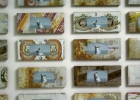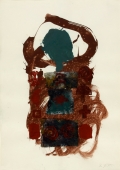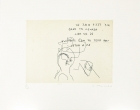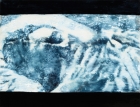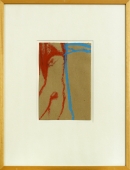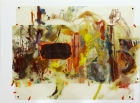Biography
Biography
born in 1966
About the work (english / deutsch)
About the work (english / deutsch)
Why does an artist paint miniatures on beverage cans? A trivial event was the trigger. During a trip to Spain, Peter Rösel wanted to spend a day fulfilling the dream of every tourist. He looked for the magnificent beach but was disappointed to find it a trash dumping site. Curious, he inspected the trash, especially the mounds of beverage cans. Soon he removed the round end pieces of some cans and flattened the different colorful and already partially rusty tins. These were taken home and Peter Rösel began to paint small landscapes on them. He had a deep feeling of certainty that the beauty of a landscape cannot be separated from civilization’s trash. It was one of those revelations that transmit latent knowledge into conscious awareness through a sudden impulse.
The beauty of a landscape that international tourism continually advertises, the myth of the untouched, and the rare magnificence of nature become our obsession more and more since we know that this authenticity is an illusion. Peter Rösel does not expose this fact, others have done this before. Instead, he lovingly paints the authentic, surrounded by civilization’s trash. Specifically, he sees it through the eyes of civilization’s trash. For him, no contradiction appears in this process. He already knows that the authentic type of beauty is infested by civilization, artificially isolated, captured often on film, and stock pilded. Through the view of the photographer it turns sublime. Peter Rösel takes this awareness as given, but he also assumes that knowledge and emotion are paradoxically nonunifiable.
If it is true that agriculture actually causes some of the greatest ecological harm, then we will hike suspiciously through idyllic fields and meadow landscapes. Since we read daily of dying trees we automatically try to detect dry twigs in forest buzzing with life.
We do not see or feel as Adalbert Stifter or Eichendorff felt, although the same strong emotions move us.
The works of Peter Rösel confront us with the question whether we should give up these strong emotions which we know are part of an illusion. Peter Rösel, who was born in 1966, argues against thinking within an either/or framework. We find it hard to bring the paradox of simultaneous knowledge and emotion internally into unison because of the way we confront it. When standing before the infinite depths of a landscape changing through light and color and being emotionally moved we are not experiencing an illusion. These emotions cannot be spoiled, provided they are not blocked by the guilt of ecological awareness.
If the strong emotions of nature are soured by collective guilt, then we cannot save it, simply because nature becomes an abstract distanced entity. Peter Rösel has not set out to paint miniatures. He paints miniatures because the aluminum surface of a world-wide standardized product had lead him to. In order to paint on these decorated tins, he nails them to a small, approximately 1,5 cm thick wooden board and bends the edges down over the sides.
His intentions become especially clear in the paintings of the surfacing whale. The continual repetition of a sequence of four painted exposures points to the fact that in almost all books about whales, exactly the same photos are found. Furthermore, the rarity of the photos signals the real difficulties involved in studying and photographing the behavior of whales.
The only knowledge Peter Rösel possesses about whales is through books. This is different from his landscapes. He has experienced them, hiked through them, and has captured and isolated them with his camera.
The painted landscape appears almost infinite through its depiction as a single excerpt, whereas the view of the whale reduces itself to a few frozen moments of motion. The excessive painted repetition of four identical motion sequences in grey and white can be compared to the mythical obsession of Captain Ahab, who hunted the white whale in Herman Melville’s Moby Dick. Meticulously, with never-ending passion and stamina, Peter Rösel paints always the same picture, at the same time exposing the myth as such and intensifying it. He reifies and internalizes the paradox as believable and as history which nourishes life through the tradition of storytelling. He does this, however, through the corroded perspective of the present. Are pollution and the extermination of fish in the oceans reasons enough to take from this great mammal its mythical, biblical dimensions? Will degradation of the environment equally degrade our emotions? (Every time I eat a yoghurt, do I have to think about the environmental impact of its container?) This double coding will drive everyone into insanity sooner or later. The alternative is to join Peter Rösel, who, like the bygone Francis of Assisi who preached the path of love, fills his paintings with love through the optics of corrosion. These optics of civilization’s trash are important to Peter Rösel. He sees that it is not necessary to connect one painting to another by means of an anecdote. This is why he insists on repetition in the whale sequence. The view into the distance is suspended. The decoration of the cans (often not recognizable due to the consuming action of rust) and the painted picture (always the same greyl white structure of movement) link up on the same level.
In the landscapes, the theme is different. My view into the distance obscures the beer or coke can in my colorful backpack and makes me forget the tavern on the next trail crossing, though clearly indicated on my hiking map. There, the forced opening of the tin can would be accompanied by the relieving sound of escaping gas.
Finally, I want to point out the single painting that shows the „Hobby builder and inventor Manfred Schwarzer and his ‘Bean-Twisting Machine’". This Manfred Schwarzer decided to alter the natural left-twisting growth in the plant. He wanted to force it into a right-handed spiral. The original picture comes from a newspaper article. This photo is symptomatic for Peter Rösels work, because it ironically depicts the human interest in changing even the 'most basic’ laws of nature. Perhaps Mr. Schwarzer thought that when beans grow in reverse they would become twice as large... („Nature Defends Itself Against the Cunning Tricks of Technology," was the title of the article.) When Peter Rösel told me that he grew up in Casablanca and Bagdad from age two to eleven, I realized that memories of these years may have had an influence on his work: The permissiveness of contradictions that is not only conditioned by the social structure but also through habits, attitudes about life, and behavior patterns. The mingling of tradition and modernity can be understood in the living present through daily experience. In the same way, rust and the material closeness of beverage cans interact with distant longing.
German text by Jean-Christophe Ammann / Translation by Niko Waesche
(Extract - Full printed version available in the Museum)
MMK - Museum für Moderne Kunst, Frankfurt am Main
Weshalb malt ein Künstler Miniaturen auf Getränkedosen? Ein ganz beiläufiges Erlebnis sollte zum Auslöser werden. Anläßlich einer Reise in Spanien wurde beschlossen, einen Tag an einem, wie es so heißt, traumhaft schönen Strand zu verbringen. Die Enttäuschung war groß, als sich dieser Strand eher als eine Müllhalde erwies. Neugierig schaute sich Peter Rösel diesen Müll an, insbesondere Berge von Getränkedosen. Er entfernte die kreisrunden Halterungen an den beiden Enden, rollte die vielfältigen, farbig bedruckten und bereits von Rostspuren übersäten Blechfolien auf, nahm sie mit nach Hause und begann, kleine Landschaften darauf zu malen, mit dem Gefühl und der Gewißheit, daß die Schönheit einer Landschaft vom Zivilisationsmüll nicht zu trennen ist. Es war wie eine jener Erkenntnisse, die latentes Wissen mittels einer plötzlichen Eingebung in eine Bewußtseinsform überführen. Die Schönheit einer Landschaft, wie sie uns der weltweite Tourismus verheißt, der Mythos des Unberührten und das seltene Naturschauspiel verfolgen uns um so mehr, als wir wissen, daß diese Authentizität eine Illusion ist. Peter Rösel entlarvt sie nicht, weil es nichts zu entlarven gibt. (Das haben andere zu anderen Zeiten getan.) Peter Rösel malt liebevoll das Authentische inmitten des Zivilisationsmülls. Oder anders ausgedruckt: Er sieht es durch die Brille des Zivilisationsmülls. Darin liegt für ihn kein Widerspruch. Er weiß, daß diese Art von Schönheit infiziert ist, künstlich ausgegrenzt und gehortet wird oder durch den Blick des Fotografen ins Sublime gewandelt wurde. Er geht davon aus, daß dies jeder weiß, aber er geht auch davon aus, daß Wissen und Empfinden ein nicht zu vereinigendes Paradox darstellen.
Wenn, wie kürzlich zu lesen war, die Landwirtschaft tatsächlich zu den großen Umweltverschmutzern gehört, dann wandert man mißtrauisch durch eine idyllische Feld- und Wiesenlandschaft. Liest man täglich vom Sterben der Bäume, sucht man auf seinem Weg durch einen vom Summen der Insekten erfüllten Wald nach kahlem und dürren Nadelholz.
Wir sehen und empfinden nicht mehr wie Adalbert Stifter oder Eichendorff, auch wenn uns die gleichen starken Gefühle bewegen.
Die Werke von Peter Rösel konfrontieren uns mit der Frage, ob wir diese starken Gefühle, obwohl sie Teil eines Trugbildes sind, aufgeben sollen. Peter Rösel, 1966 geboren, plädiert gegen ein Entweder - Oder. Das Paradox, das wir gefühlsmäßig nicht in Einklang zu bringen vermögen, hat mit der Einstellung diesem Paradox gegenüber zu tun. Die Schönheit, der ergreifende Blick in die unendliche Tiefe einer in Licht und Farbe sich wandelnden Landschaft ist kein Trugbild. Ein Erlebnis, das durch nichts zu vergällen ist, vorausgesetzt, daß das ökologische Bewußtsein einem nicht als Schuldgefühl im Wege steht.
Wird mir das starke Gefühl inmitten der Natur durch die kollektive Schuld an der Natur vergällt, werde ich sie niemals „retten“ können. Ganz einfach, weil diese Natur zu einer abstrakten, funktionalen Größe gerät.
Peter Rösel ist kein Miniaturmaler. Er malt Miniaturen, weil ihn die Aluminiumfläche eines weltweit standardisierten Wegwerfproduktes dazu veranlaßt. Um auf dem bedruckten Blech überhaupt malen zu können, nagelt er es auf ein kleines, ca. 1,5 cm starkes Brett, und zwar so, daß die Seiten dieses Bretts vom Blech mit eingefaßt sind.
In den Blöcken mit der Darstellung eines auftauchenden Walfisches wird seine Methode besonders deutlich. Das kontinuierliche Wiederholen einer Sequenz, bestehend aus vier Bildern, jedes fünfmal gemalt, verweist auf den Umstand, daß in fast allen Büchern über Wale häufig die gleichen Abbildungen zu finden sind, zum anderen, daß die seltenen Fotos auf die Schwierigkeit hinweisen, diese Tiere in ihrem Verhalten zu erforschen. Peter Rösel selbst besitzt nur ein Buchwissen über Walfische. Ganz anders verhält es sich mit den Landschaften. Er kennt sie aus eigener Erfahrung, hat sie durchwandert, hat die Ausschnitte fotografisch festgehalten. Während Landschaft durch die Erschließung eines einmaligen Ausschnitts schier grenzenlos erscheint reduziert sich der Blick bei dem Wal auf wenige Bewegungsmomente. Die exzessive malerische Wiederholung von vier jeweils identischen Bewegungsabläufen in grau-weiß wird zur quasi mystischen Obsession des Kapitäns Ahab in Herman Melvilles Moby Dick, der den weißen Wal jagte. Akribisch, mit nicht nachlassender Leidenschaft und Energie malt Peter Rösel das immer gleiche Bild, den Mythos entthronend und gleichzeitig intensivierend. Er verdinglicht und verinnerlicht das Paradox als das Glaubhafte und als Geschichte, die durch die Tradition der Erzählung das Leben nährt, jedoch aus der korrodierten Perspektive der Gegenwart. Sind die Verschmutzung und das Leerfischen der Weltmeere ein Grund, diesem gewaltigen Säugetier seine mythische (biblische) Dimension zu nehmen? Wird durch die Degradierung der Bedingungen unser Gefühl gleichermaßen degradiert? Muß ich allem, was gefährdet ist, mit dem Gefühl von dessen Gefährdung begegnen? (Muß ich bei jedem Joghurt, das ich esse, an die Entsorgung des Bechers denken?) Diese Doppelcodierung treibt jeden früher oder später in den Wahnsinn, oder er schließt sich Peter Rösel an, der wie weiland Franz von Assisi die Liebe predigte, denn jedes seiner Bilder ist aus der Optik der Korrosion - von Liebe erfüllt. Diese Optik des Zivilisationsmülls ist Peter Rösel wichtig. Es kann nicht darum gehen, das eine Bild mit dem anderen anekdotisch zu verbinden. Deshalb insistiert er auf der Wiederholung der Walsequenz. Der Blick in die Ferne wird aufgehoben. Dosendekor, oft bis zur Unkenntlichkeit vom Rost zerfressen, und gemaltes Bild - die immer gleiche, grau-weiße Bewegungsstruktur - greifen auf der gleichen Ebene ineinander.
In den Landschaftsbildern ist die Thematik anders. Der Blick in die Ferne verrät nichts über die Bier- oder Cola-Dose in meinem bunten Rucksack oder über das Wirtshaus bei der nächsten Wegkreuzung, deutlich auf der Wanderkarte verzeichnet, wo das Aufreißen des Dosendeckels von einem erlösenden Zischen begleitet wird.
Zum Schluß noch ein Hinweis auf jenes Einzelbild, das den „Hobbybastler Manfred Schwarzer mit seiner Bohnendrehmaschine“’ zeigt. Dieser Manfred Schwarzer kam auf die Idee, grüne Bohnen statt in der ihnen wachstumseigenen Linksbewegung auf eine Rechtsbewegung zu programmieren. Die Vorlage stammt aus einer Zeitung.
Ein für Peter Rösel symptomatisches Bild, weil es ironisch die Neugier des Menschen beschreibt, auch die „einfachsten“ Naturgesetze zu verändern. Vielleicht hat sich Herr Schwarzer vorgestellt, daß, wenn die Bohnen rechtsherum wachsen, sie doppelt so groß werden ... („Natur wehrt sich gegen List der Technik“, so der Titel in der Zeitung.)
Als mir Peter Rösel erzählte, daß er von seinem zweiten bis elften Lebensjahr in Casablanca und Bagdad aufgewachsen ist, kam mir der Gedanke, daß möglicherweise Jugenderinnerungen mit in seine Arbeiten hineingewirkt haben: Jene Permissivität von Gegensätzlichem, das nicht allein durch das soziale Gefälle, sondern durch Gewohnheiten, Lebens- und Verhaltensweisen geprägt ist. Tradition und Moderne vermischen sich hautnah in der alltäglichen Erfahrung und im Erleben von Gegenwart, so wie sich Rost und plakative Nähe der Getränkedosen an der Ferne der Sehnsucht reiben.
Text von Jean-Christophe Ammann
(Auszug - Der vollständige Text ist als Informationsblatt beim Museum erhältlich)
MMK - Museum für Moderne Kunst, Frankfurt am Main
Bibliography
Bibliography
(taken from/aus: Ausstellungskatalog „Peter Rösel - Arbeiten auf Dosenblech 1991-92“, Galerie Paul Sties, Frankfurt am Main 1992)
 offers / Requests
offers / Requests
Filter
| Image | Artist | Title | Year | Material | Ending | Price | Offer/Request | ||||||||||||||||||||||||||
|---|---|---|---|---|---|---|---|---|---|---|---|---|---|---|---|---|---|---|---|---|---|---|---|---|---|---|---|---|---|---|---|---|---|
 |
Peter Rösel | Mini Moringa XL | 2000 | Genäht aus deu ... | Aug 13, 2019 | On Request | Offer | ||||||||||||||||||||||||||

Peter RöselMini Moringa XL Offer ID 323
|
|||||||||||||||||||||||||||||||||
 |
Peter Rösel | Anturie | 2000 | Polizeiuniforms ... | Aug 13, 2019 | On Request | Offer | ||||||||||||||||||||||||||

Peter RöselAnturie Offer ID 324
|
|||||||||||||||||||||||||||||||||
 Exhibition Announcements Exhibition Announcements 
| Learn more about this service |
|---|
 Visualization |
Learn more about this service | ||
|---|---|---|---|

Interested in discovering more of this artist's networks?
3 easy steps: Register, buy a package for a visualization, select the artist.
See examples how visualization looks like for an artist, a curator, or an exhibition place: Gallery, museum, non-profit place, or collector.

Exhibition History

|
SUMMARY based on artist-info records. More details and Visualizing Art Networks on demand. Venue types: Gallery / Museum / Non-Profit / Collector |
||||||||||||
| Exhibitions in artist-info | 48 (S 21/ G 27) |
Did show together with - Top 5 of 453 artists (no. of shows) - all shows - Top 100
|
||||||||||
| Exhibitions by type | 48: 22 / 5 / 19 / 2 | |||||||||||
| Venues by type | 32: 9 / 3 / 18 / 2 | |||||||||||
| Curators | 6 | |||||||||||
| artist-info records | Mar 1993 - Nov 2016 | |||||||||||
|
Countries - Top 3 of 3 Germany (38) Switzerland (2) United States (1) |
Cities - Top 5 of 17 Frankfurt am Main (18) Berlin (9) München (3) Hamburg (3) Wiesbaden (2) |
Venues (no. of shows )
Top 5 of 32
|
||||||||||
Curators (no. of shows)
Top 5 of 6
|
| Galerie Martina Detterer | G | Oct 2016 - Nov 2016 | Frankfurt am Main | (149) | +0 | |
| Loock Galerie | S | Mar 2016 - Apr 2016 | Berlin | (49) | +0 | |
| Galerie Martina Detterer | S | Sep 2015 - Oct 2015 | Frankfurt am Main | (149) | +0 | |
| Deutsche Bank Collection - Artists | S | Apr 2015 - Apr 2015 | Frankfurt am Main | (1) | +0 | |
| Galerie Martina Detterer | G | Dec 2014 - Jan 2015 | Frankfurt am Main | (149) | +0 | |
| Neuer Kunstverein Giessen | S | Jul 2014 - Aug 2014 | Giessen | (63) | +0 | |












